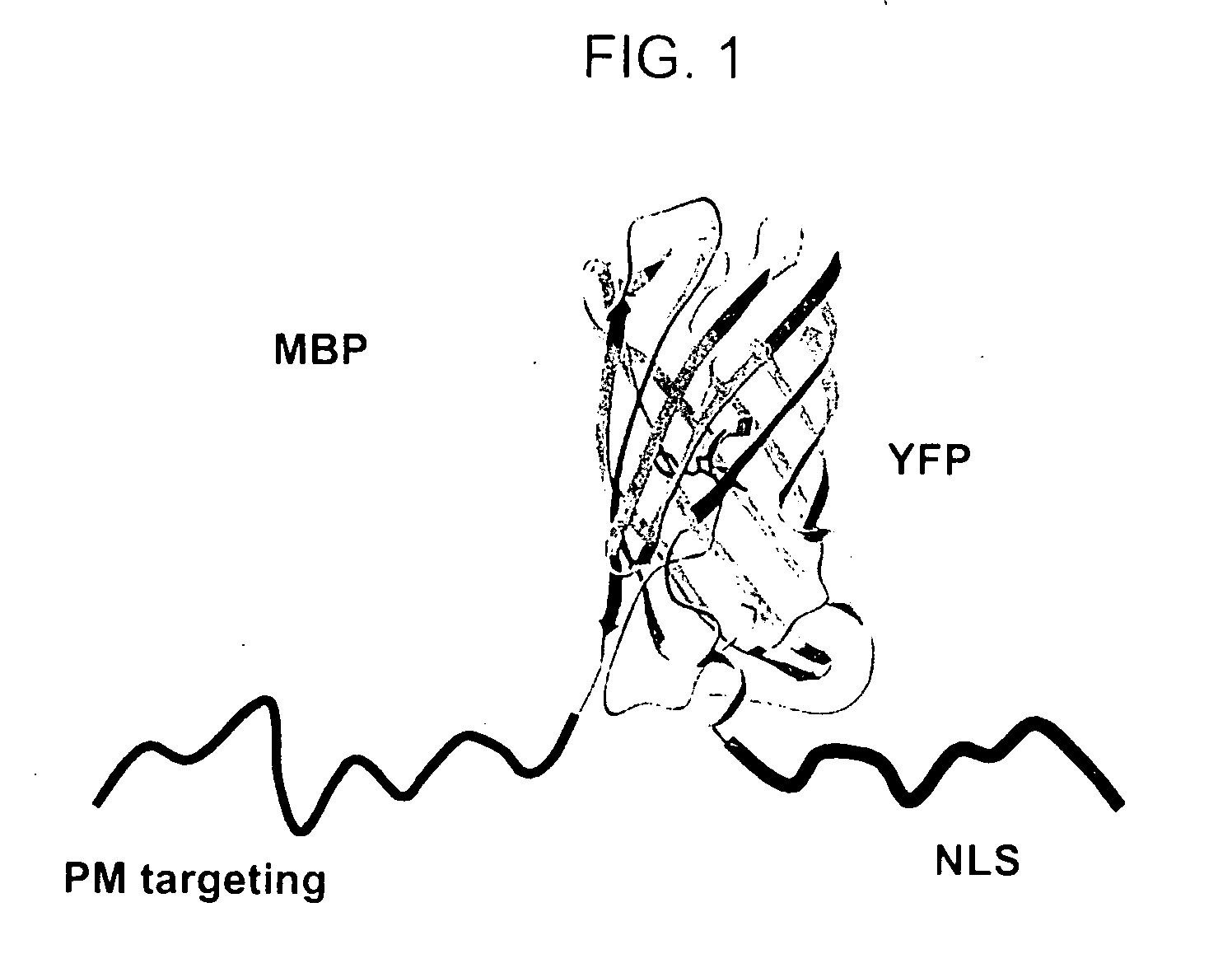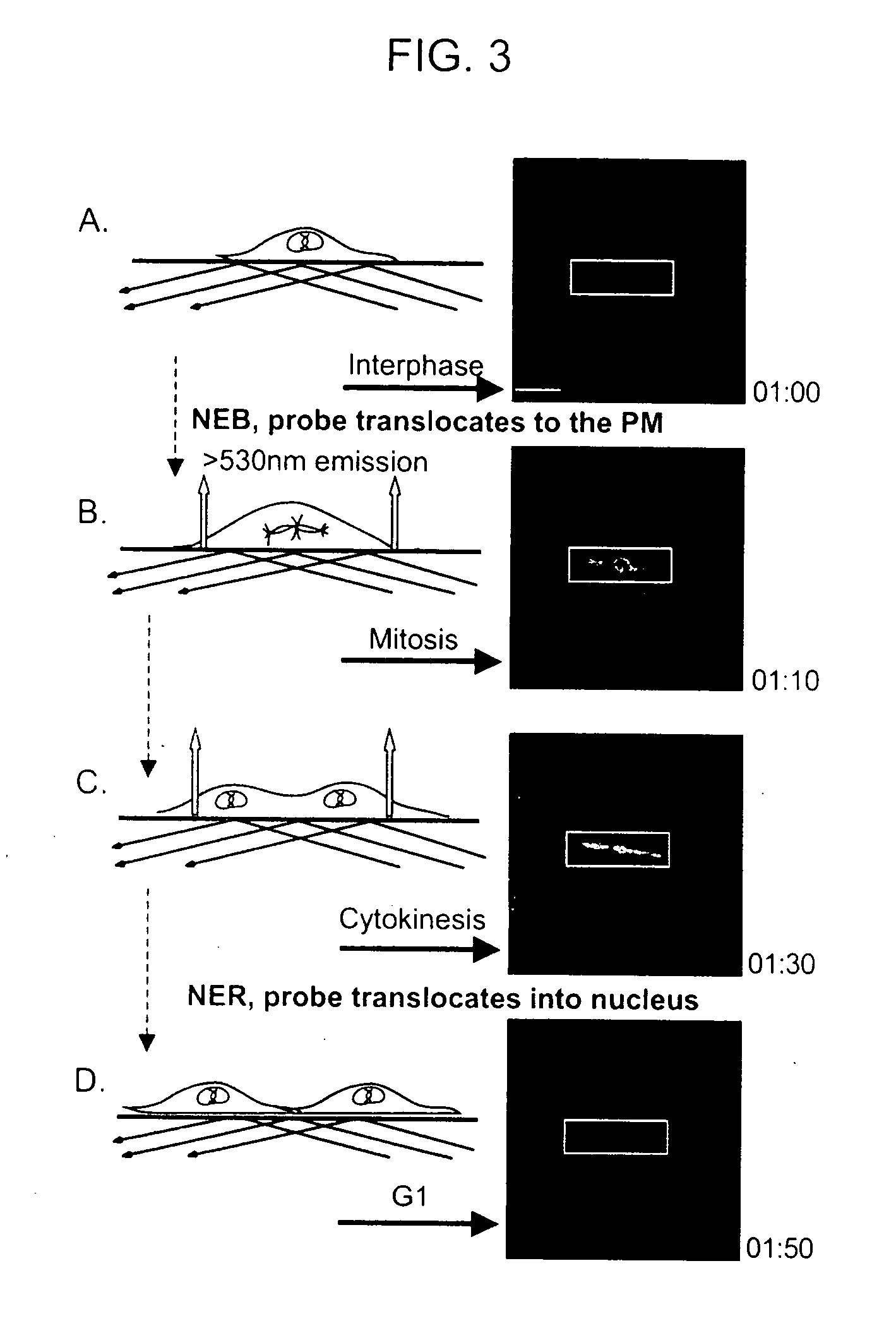Live-cell biosensor polypeptides and methods of use
a biosensor and live cell technology, applied in biochemistry apparatus and processes, instruments, material analysis, etc., can solve the problems of difficult temporal resolution of specific cell cycle phases (e.g., mitosis) at the single cell level, and the difficulty of observing mitotic timing in statistically significant cell numbers,
- Summary
- Abstract
- Description
- Claims
- Application Information
AI Technical Summary
Problems solved by technology
Method used
Image
Examples
example 1
Design of the Live-Cell Biosensor Polypeptide
[0196] A mitosis biosensor polypeptide composed of three components—a reversible plasma membrane (PM) targeting domain, a fluorescent polypeptide, and a nuclear localization signal (NLS)—was produced as described above. In this example, the MBP included a reversible PM targeting domain fused to the NH2 terminus of a yellow fluorescent protein (EYFP), which was in turn fused to the NH2 terminus of a nuclear localization signal (EYFP-NLS, Clontech laboratories, Palo Alto Calif.) (FIG. 1).
[0197] A plasma membrane (PM) targeting motif based on polybasic residues was added at the N-terminus of an YFP-NLS (yellow fluorescent protein—nuclear localization signal) construct, as described in greater detail in the Examples section. The structure of YFP was adapted from Rekas et al., J. Biol. Chem. 50:573-578 (2002). It was hypothesized that a nuclear localization signal would ensure the biosensors localization to the nucleus during the G1, S, and ...
example 2
Location of the Biosensor Monitored by TIRF Microscopy
[0199] To determine if the change in fluorescence at the membrane could be monitored by TIRF microscopy, the same live cell imaging setup used in the confocal experiments above was adapted to a prism-based CFP / YFP TIRF system (FIG. 3). During interphase, no significant plasma membrane fluorescence was measured with TIRF, however, after NEB there was a large increase in plasma membrane fluorescence (FIG. 3, panels B and C). This fluorescence was maintained until the nuclear envelopes of the two daughter cells reformed and the biosensor translocated back into the nucleus. Translocation into the nucleus was paralleled by a rapid loss in plasma membrane fluorescence measured by TIRF microscopy (FIG. 3, panel D). Because the MBP is monitored by the less toxic TIRF microscopy, we were able take images at a rate of up to 2 images per minute, compared to every 5 minutes with epifluorescence imaging and 15 with confocal imaging, thus gre...
example 3
Monitoring Many Mitotic Events Using Wide Field TIRF
[0200] Based on the findings in the example above, a wide field TIRF microscope was used to monitor many mitotic events in the same experiment. FIG. 4 (panels A and B) shows two planes of a 5-hour TIRF experiment that was recorded through a 10× objective in which 70 cells proceeded through mitosis. In order to analyze these traces, the background was measured and subtracted from the fluorescence over time at each location where a mitotic event occurred. Typical examples of such individual traces are shown in FIG. 4, panel C. These results confirm that the time-period between nuclear envelope breakdown and reformation can indeed be measured from the TIRF signal, enabling an accurate quantification of the duration of mitosis.
Example 4
Detecting NEB, Anaphase, and NER with the Mitosis Biosensor
[0201] In 58 of the 70 cells (83%) that went through mitosis in the experiment above, a second smaller increase in plasma membrane fluoresce...
PUM
| Property | Measurement | Unit |
|---|---|---|
| TIRF time lapse | aaaaa | aaaaa |
| fluorescence | aaaaa | aaaaa |
| fluorescence emission spectra | aaaaa | aaaaa |
Abstract
Description
Claims
Application Information
 Login to View More
Login to View More - R&D
- Intellectual Property
- Life Sciences
- Materials
- Tech Scout
- Unparalleled Data Quality
- Higher Quality Content
- 60% Fewer Hallucinations
Browse by: Latest US Patents, China's latest patents, Technical Efficacy Thesaurus, Application Domain, Technology Topic, Popular Technical Reports.
© 2025 PatSnap. All rights reserved.Legal|Privacy policy|Modern Slavery Act Transparency Statement|Sitemap|About US| Contact US: help@patsnap.com



